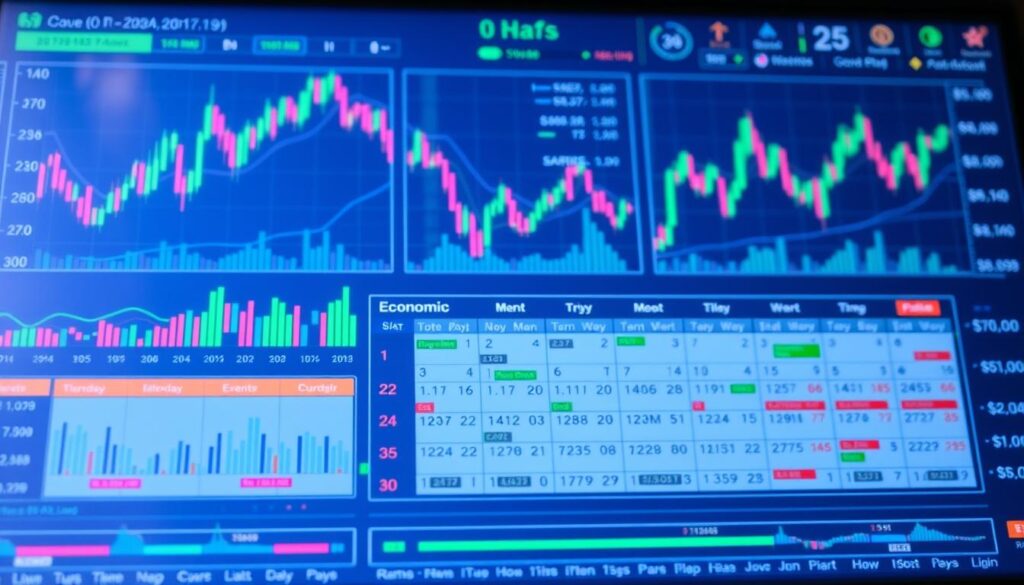Economic Calendar Forex: Real-Time Updates and Analysis
In fast-paced financial markets, staying ahead requires precise timing and reliable insights. Traders rely on specialized tools to track critical events that shape currency valuations. One such resource offers real-time updates on announcements like interest rate changes, employment data, and geopolitical developments.
This scheduling tool acts as a roadmap for market participants. It highlights periods of potential volatility, helping users align strategies with their risk preferences. Events are often ranked by their projected impact, allowing traders to focus on high-priority updates without missing crucial details.
Modern platforms integrate seamlessly with browsers, delivering instant alerts when key reports go live. This feature proves particularly valuable for professionals managing multiple currency pairs. By understanding how scheduled events influence price action, traders can position themselves strategically before major announcements occur.
The connection between market movements and institutional updates forms the core of effective fundamental analysis. Successful practitioners use these tools to filter noise from actionable data, adapting their approaches to ever-changing conditions. With proper implementation, traders gain clearer insights into optimal entry and exit points across time zones.
Understanding the Forex Economic Calendar
Effective trading strategies hinge on timely access to market-moving information. Specialized schedules help investors track institutional updates that shape exchange values. These tools organize announcements like central bank decisions and employment statistics, highlighting their potential impact on price trends.
Core Principles of Exchange Rate Dynamics
Currency values respond to supply-demand shifts caused by policy changes and data releases. When national banks adjust interest rates, they directly influence investment flows. Higher borrowing costs typically boost demand for a nation’s money, while cuts may reduce its global appeal.
Key indicators like GDP growth figures reveal economic health. Positive surprises often strengthen a country’s exchange value, while weak results prompt sell-offs. Traders analyze these patterns to predict short-term volatility and long-term trends.
How Scheduled Updates Drive Price Action
Major announcements create immediate reactions across pairs. Markets price in expectations before releases, but unexpected results amplify movements. For example, a rate hike larger than predicted could trigger rapid appreciation.
Regular data cycles allow preparation for volatility windows. Traders often focus on high-impact events like inflation reports or manufacturing surveys. By aligning positions with these timelines, they capitalize on predictable liquidity surges while managing risks.
How to Use economic calendar forex for Strategic Trading

Strategic traders know precision often separates profit from missed opportunities. By aligning actions with scheduled updates, they navigate volatility while minimizing unnecessary risks. This approach transforms raw data into actionable insights through careful planning.
Identifying High-Impact Events
Focus first on releases with proven power to move markets. Manufacturing PMI figures rank among top-tier indicators, signaling industrial growth or decline. Values above 50 suggest expansion, often boosting a currency’s appeal against peers.
Services PMI data carries equal weight in developed nations. Since service sectors dominate modern economies, surprises here frequently trigger swift price shifts. Central bank rate announcements remain critical, as borrowing costs directly affect investment flows.
Interpreting Event Data and Historical Trends
Compare current results with forecasts and prior readings. A manufacturing PMI beating expectations might strengthen a currency temporarily. However, check if the trend aligns with broader economic narratives for sustained moves.
Review how pairs reacted to past rate changes or trade reports. If the EUR/USD consistently drops after weak German factory data, prepare similar scenarios. Always cross-reference consensus estimates with real-time figures to spot deviations.
Build contingency plans for both upside and downside surprises. This dual preparation helps traders adapt swiftly when services PMI or employment stats defy predictions. Historical patterns offer guidance but require context-aware adjustments.
Interpreting Economic Indicators through a Forex Lens

Market movements often hinge on data-driven insights from key financial reports. Five core metrics shape currency valuations: consumer spending patterns, price stability metrics, labor statistics, factory outputs, and growth benchmarks. Each offers unique clues about national financial health.
Analyzing Retail Sales, CPI, and Employment Figures
Retail sales data acts as a heartbeat monitor for consumption-driven economies. Monthly spikes suggest rising consumer confidence, often strengthening domestic currencies. Analysts compare these figures against inflation-adjusted values to filter noise.
The Consumer Price Index (CPI) directly impacts central bank decisions. When inflation overshoots targets, rate hikes become likely – a scenario that typically boosts currency demand. Traders watch revisions closely, as recalculations alter long-term expectations.
Employment statistics reveal workforce dynamics beyond headline job numbers. Wage growth trends and participation rates help predict spending capacity. Sustained hiring surges often precede tighter monetary policies, making these releases critical for position adjustments.
Evaluating Industrial Production and GDP Trends
Industrial production metrics track manufacturing vitality. Expanding outputs signal economic momentum, favoring currency appreciation. Capacity utilization rates above 85% often hint at inflationary pressures, prompting preemptive policy moves.
GDP revisions provide the broadest growth snapshot. Markets react sharply when quarterly results diverge from forecasts. Sector-specific breakdowns help identify structural strengths – tech-driven expansions may carry different currency implications than resource-based booms.
Seasonally adjusted data requires careful interpretation. Unexpected winter production slumps or summer retail dips can distort year-over-year comparisons. Savvy traders cross-reference multiple indicators to separate temporary anomalies from lasting trends.
Forecasting Market Volatility with the Economic Calendar
Market turbulence often follows predictable rhythms when you know where to look. Scheduled updates from institutions create waves traders can ride or avoid. Historical patterns reveal how specific events trigger price swings, helping refine risk management strategies.
Assessing Interest Rates and Central Bank Announcements
The EUR ECB policy decisions rank among the most influential volatility drivers. When rate changes align with inflation trends, currency pairs like EUR/USD often see rapid moves. Analysts dissect meeting minutes for clues about future adjustments.
Three factors shape effective forecasting:
- Central bank tone: Subtle shifts in ECB President Lagarde’s language hint at policy directions weeks before official changes
- Inflation comparisons: Current CPI data versus target ranges predicts rate hike probabilities
- Market positioning: Extreme bullish or bearish sentiment before announcements amplifies reactions
Recent ECB President Lagarde speeches have focused on balancing growth and price stability. Traders compare these statements with economic conditions to gauge timing. For example, persistent inflation above 2% often precedes tighter policies.
Volatility spikes typically occur when actual data diverges from forecasts. A rate hold during rising inflation might trigger larger moves than expected cuts. By tracking these relationships, traders set smarter stop-loss levels and profit targets.
Integrating News Events and Fundamental Analysis into Trading Strategies

Market shifts often emerge from both scheduled updates and surprise developments. Combining real-time alerts with deep financial assessments helps traders navigate these dual challenges effectively. This approach blends structured data with adaptive responses to evolving conditions.
Monitoring Political and Fiscal Announcements
Government decisions frequently alter currency trajectories overnight. Trade agreements or stimulus packages can boost a nation’s currency demand within hours. The USD ISM Services report exemplifies this, reflecting shifts in America’s dominant economic sector.
Three critical factors for tracking policy changes:
- Unexpected timing: Emergency rate decisions often bypass standard schedules
- Geopolitical context: Trade wars amplify the impact of manufacturing data
- Market sentiment: Pre-event positioning magnifies post-announcement volatility
Reacting to Unforeseen Market Shifts
When manufacturing PMI readings deviate sharply from forecasts, swift adjustments become essential. A services sector index plunging below 50 might signal recession risks, prompting defensive position changes. Traders cross-reference these signals with technical patterns for confirmation.
The USD ISM Manufacturing index serves as an early warning system. Strong figures often precede dollar rallies, while weak data may trigger sell-offs. By pairing these insights with breaking news analysis, traders build strategies resilient to sudden changes.
Adaptability proves crucial when political events disrupt forecasts. Regular review of services PMI trends and policy statements helps maintain strategic flexibility. This dynamic approach turns market turbulence into calculated opportunities.
Creating a Daily Routine with the Forex Economic Calendar

Consistent success in currency markets demands structured preparation. Integrating scheduled event tracking into daily habits helps traders stay aligned with market rhythms while minimizing oversights.
Crafting a Daily Trading Checklist
Morning reviews should start by filtering high-priority announcements. Focus on events like GBP BoE Gov statements, which often reshape British pound valuations. A systematic checklist might include:
- Verifying time zones for key releases
- Marking pairs affected by BoE Gov Bailey speeches
- Adjusting orders near support/resistance levels
Prioritize updates influencing specific currency pairs in your portfolio. For GBP traders, BoE Gov Bailey’s testimonies often require immediate attention due to their impact on prices.
Syncing Calendar Tools with Your Browser
Modern traders use browser extensions to merge market tracking with workflow. These tools flash alerts for critical events like GBP BoE Gov rate decisions directly on-screen. Three synchronization benefits stand out:
- Instant notifications during research or analysis
- Custom filters for currency-specific announcements
- One-click access to historical data comparisons
When BoE Gov Bailey addresses Parliament, synchronized tools ensure traders don’t miss nuanced policy hints affecting orders. This integration helps maintain focus while monitoring multiple prices across sessions.
Strategies for Risk Management during High-Impact Events

Navigating turbulent markets demands precise safeguards. Savvy traders use targeted techniques to shield positions while capturing opportunities during volatile data releases.
Setting Stop-Loss and Take-Profit Orders
Volatility spikes around major announcements require adaptive order placement. Analyze historical prices to determine typical movement ranges after events like USD JOLTS Job Openings reports. This helps set stop-loss levels beyond normal fluctuations.
For inflation-driven moves, widen protection buffers. CPI revisions often create sustained trends rather than temporary jumps. Place take-profit targets at technical resistance zones if average hourly earnings data exceeds forecasts.
Balance risk parameters across correlated pairs. A strong trade balance report might lift one currency while pressuring others. Adjust orders proportionally to avoid overexposure during simultaneous releases.
Monitor wage growth indicators closely. Unexpected spikes in average hourly earnings frequently alter rate hike probabilities. Pair these insights with USD JOLTS Job figures to assess labor market heat.
Always test strategies against multiple scenarios. Simulate how positions react if prices gap through key levels post-announcement. This preparation prevents panic decisions when volatility peaks.
Utilizing Real-Time Tools and Data for Informed Trading Decisions

Modern trading thrives on split-second information flow, where delayed reactions can erase profit margins. Advanced tools now deliver critical updates directly to traders’ screens, transforming how markets are navigated. These systems filter noise while amplifying signals that move currency valuations.
Leveraging Notifications and Browser Integrations
Browser plugins and mobile alerts keep traders synchronized with live data streams. When manufacturing PMI figures release, customized notifications highlight deviations from forecasts. This helps professionals spot opportunities during German factory data or Japanese industrial reports.
Services PMI updates demand equal attention. These indicators often trigger swift euro or dollar movements when service sector health shifts. Traders using integrated tools receive pop-ups before markets fully price in new information.
The EUR unemployment rate serves as a pulse check for eurozone stability. Unexpected jumps often precede ECB policy shifts, making real-time tracking essential. Similarly, USD factory orders data reveals manufacturing demand trends that shape dollar momentum.
Three advantages define effective notification systems:
- Custom filters for specific currencies or event types
- Historical comparisons alongside live data
- Multi-platform synchronization across devices
By mastering these tools, traders convert raw data into informed trading decisions. Instant access to manufacturing PMI surprises or USD factory orders revisions allows precise position adjustments before crowds react.
Final Insights for Agile and Informed Forex Trading
Agile traders thrive by transforming information into strategic action. Mastering scheduled data releases helps anticipate market movements before they unfold. Key metrics like private sector credit expansions signal economic momentum, often foreshadowing currency shifts.
AUD private sector lending trends reveal Australia’s financial health, directly influencing its dollar’s global standing. Similarly, CHF retail sales patterns expose Swiss spending habits that sway franc valuations. These indicators become vital when aligning positions with emerging trends.
Japanese JPY household spending data and housing reports offer clues about domestic demand. Rising consumer confidence typically boosts currency appeal, while contractionary signals prompt defensive adjustments. Traders cross-reference these insights with broader investment flows to validate hypotheses.
Successful strategies balance real-time alerts with disciplined account management. Regularly tracking consumer activity and credit growth helps refine entry points. By integrating these tools, traders convert raw data into actionable intelligence – turning volatility into calculated opportunities.
Knowledge remains the ultimate edge in global markets. Staying prepared for scheduled updates builds resilience against unpredictable swings, empowering smarter decisions in fast-moving conditions.






